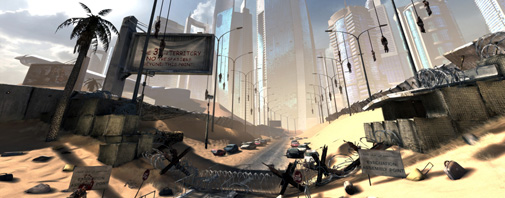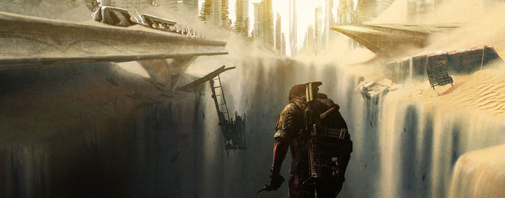So this is going be the first in a new series of interviews which I’m calling Aftermath, in which I’ll be taking to key creators of recently released games, with a twist. It’ll be a no holds-barred, warts and all look at the game for those who have already completed it and want extra insight into the creative process straight from the horse’s mouth. That means spoilers, people. It’s always seemed unfair to me that, for the most part, once a game is released then the reviews are the final source of information beyond playing the game itself. Games don’t come with a ‘Director’s Commentary’, so hopefully our Aftermath will help plug that gap.
Enormous plot spoilers below.
For the first edition, I’ve been in discussion with the Lead Writer of the truly fantastic Spec Ops: The Line, Walt Williams. Last month I gave Spec Ops: The Line 9/10, the best score of any game I’ve played this year, so here’s our chance to dig deeper and walk The Line with one of it’s main creators.
You have been warned: huge, bone-crushing spoilers below.
 Jordan Garland: To anybody who has completed Spec Ops: The Line, the stand-out scene in the game has to be White Phosphorus. That scene was both compelling and mortifying in equal measure, what challenges did you face when depicting something so horrific?
Jordan Garland: To anybody who has completed Spec Ops: The Line, the stand-out scene in the game has to be White Phosphorus. That scene was both compelling and mortifying in equal measure, what challenges did you face when depicting something so horrific?
Walt Williams: There are 3 challenges when trying to create a scene like “White Phosphorus.” The first, and to me this was the biggest challenge we faced throughout the game, was making it feel organic. It would have been very easy for a game like Spec Ops to fall back on exploitation and shock value. But we made a choice early on that every horrific moment in the game had to be earned. If it wasn’t the obvious result of cause and effect, and if it wasn’t absolutely key to the narrative, then we threw it out.
The second challenge was getting the Player to take part in such a terrible act. This is where the brilliant designers at Yager had the idea of mimicking the “Death From Above” mission in Modern Warfare. The idea was that we, as gamers, have been trained to disconnect from a game when the gameplay experience drastically changes. We stop thinking about the enemies as Soldiers and instead see them as glowing dots that need to be turned off. Once the Player disconnects from the reality of the situation, something truly horrible happens. And it hits Players in the gut, because now they have to face the consequences of their actions. They don’t get teleported to the next location. They have to face the human cost of their actions.
Finally, the third challenge is animation. Writing a scene for an actor is very different than writing it for an animation team. Walker’s reaction to what he has done is told almost entirely through his facial expressions. Again, that we were able to pull this scene off is due entirely to the amazing animators at Yager.
JG: In creating something so compelling and, to some extent, distressing, did you ever find yourself in a position where the creative process had desensitized you to the horror it depicted?
WW: In many ways, I wish it had desensitized me, but unfortunately, it did not. To be honest, Spec Ops was emotionally a very hard game to write. You don’t simply come up with horrible scenes, you also have to live them through the eyes of your characters. You have to get inside their heads, see these horrors through their eyes. Then, you have to destroy them on every level.
This would be hard enough to experience just once. But, writing a project like this takes time. About 3 years, to be exact. That is a very long time to be immersed in a game like Spec Ops. There were definitely times when I wanted to walk away from the project, because it was taking a serious toll on my life. But in the end, I couldn’t walk away from a story and project that was so personal to me and the team at Yager.
 JG: Is it a nod towards real-life atrocities, such as the infamous Wikileaks ‘Collateral Murder’ video?
JG: Is it a nod towards real-life atrocities, such as the infamous Wikileaks ‘Collateral Murder’ video?
WW: No. We made a decision early on to not connect Spec Ops with any real world conflicts or situations. The connection “White Phosphorus” has to reality is simply that these things do happen. Our actions do not always play out as intended. We cannot always control the consequences of our decisions. Horrible things happen to people every day. They have to make the decision to keep going. Whether that involves lying to themselves or to others, that’s entirely up to them.
JG: It’s quite refreshing to see a genuine comment on another title beyond pure mindless tribalism. Is Spec Ops: The Line not only a critique of war itself, but its portrayal in video games in general?
WW: The reference is real world video. But the strength of the scene comes the established DfA sequence in Modern Warfare. When two games draw from the same real-world source, you cannot avoid comparisons. That Spec Ops forces the Player to face the aftermath of this reality could be seen as a critique of war in games. But really, we just wanted to be true to the situation. We didn’t want the Player to be able to hide from the consequences of his actions.
JG: Did you ever consider making the mortar scene optional, like other instances further down the line?
WW: It is optional, to an extent. The Player can open fire on the Soldiers using their normal weapons, but they are severely outnumbered. The Player will eventually run out of ammo and be overcome. Is that necessarily fair? No. But it’s not until you’ve used the mortar and seen the consequences of your actions that you start to wonder, “Could I have done something different?” And the answer is no. It was your only real option. To which you might say, “That’s not fair.” And I’d say, “You’re right.”
That’s a real emotional response and I can guarantee it’s exactly what Walker is feeling in that moment.
The choice isn’t “Do I use the mortar or not?” The real choice is “Can I keep going, knowing what I’ve done?”
 JG: After that scene, you’re thrown straight back into the action and I for one was totally bewildered, was this yo-yoing of emotion something you wanted to explore?
JG: After that scene, you’re thrown straight back into the action and I for one was totally bewildered, was this yo-yoing of emotion something you wanted to explore?
WW: It is. We didn’t want the world to cater to the Player’s desires. In that moment, you wanted to digest what just happened. But there are other people in the world and they want to kill you for the same reason. In many ways, this is what “The Line” is all about. Some people think it means “The Line you don’t want to cross or have to cross.” But really, it’s The Line between expectations and reality. As gamers, we expect a game to embrace us… to yield to us and our actions. Spec Ops, however, opposes you. It subverts your expectations and reminds you that you are not in control. And that was entirely by design.
JG: Is Spec Ops: The Line a comment on the shooting genre, rampant glorification of war depicted with very little consequence, was this something you consciously wanted to address?
WW: “War is hell” isn’t just a saying. It’s true. You’d probably find it difficult to find someone who disagrees with the statement. And yet, we have allowed war to exist strictly as entertainment within video games. No other medium treats war strictly as a spectacle. With Spec Ops, we weren’t trying to make people feel bad about playing shooters, although that certainly is one reaction people are having. Our goal was simply to make people think—about the games the play and the reasons they play them.
JG: Was the player’s experience always intended to mirror Walker’s? You enjoy the killing and destruction as much as he does, so did you desire for the player to also feel guilty?
WW: Absolutely. On the surface, Spec Ops can be classified as a military game—you are a soldier in conflict against soldiers. But really, Spec Ops is a story about who we are as gamers… about the entertainment we choose to consume and our reasons for doing so. Walker comes to Dubai, wanting to feel heroic and powerful. He wants to overcome obstacles and save the day. Just like us, every time we sit down to play a game.
 JG: Spec Ops: The Line’s various flash-points provide gamers with split-second decision points, where the most obvious route ‘out’ is arguably the most objectionable. How did you want players to react in these desperate situations?
JG: Spec Ops: The Line’s various flash-points provide gamers with split-second decision points, where the most obvious route ‘out’ is arguably the most objectionable. How did you want players to react in these desperate situations?
WW: Believe it or not, we had no specific desire for players to make one choice over another. We tried very hard to remove any judgment from those scenes. Our hope was that players would follow their own hearts… whether their heart was feeling vengeful or merciful, that was entirely up to the Player.
JG: Nolan North, the voice actor for Captain Walker, also voiced the indomitable Nathan Drake, known for his almost blasé approach to the merciless slaughter of hundreds. Were you involved in the casting process and was casting him a conscious decision?
WW: I was involved with casting and I’d love to say we were brilliant to cast Nolan as a means of subverting Player expectation. But, the truth is, we hired Nolan simply because he is a fantastic actor with tremendous range. He’s also a great guy and a pleasure to work with. In fact, Nolan worked on Spec Ops for at least 4 years. He was the very first actor we cast. He even did the scratch VO for an internal vertical slice demo. Needless to say, he spent a long time with Captain Walker and really took the opportunity to explore his darker side.
JG: You’ve managed to make a great game with great endings, the holy grail of everything video-games. Just how many endings are there in total?
WW: There are 4 official endings and 1 unofficial ending. 1 in Konrad’s penthouse. 3 in the epilogue. And 1 in real life, for those players who decide they can’t go on and put down the controller.
And that’s all for the very first Aftermath, and I hope it was as insightful for you as it was for me. Spec Ops: The Line is a prime example of substance over gameplay, but give me a choice and I’ll choose narrative every single time.













